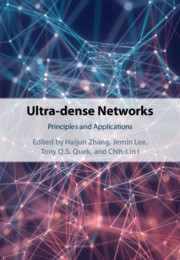Book contents
- Frontmatter
- Contents
- List of Contributors
- Part I Overview
- Part II Physical Layer Design
- 3 NOMA-Based Ultra-dense Networks
- 4 Physical Layer Security in Ultra-dense Networks
- 5 Millimeter-Wave Multiantenna Ultra-dense Networks
- 6 Interference Management in Ultra-dense Networks
- 7 3D-Based Base Station Deployment in Ultra-dense Networks
- 8 Power Control in Full-duplex Ultra-dense Heterogeneous Networks
- Part III Resource Allocation and Network Management
- Part IV Field Trials and Tests
- Index
7 - 3D-Based Base Station Deployment in Ultra-dense Networks
from Part II - Physical Layer Design
Published online by Cambridge University Press: 12 October 2020
- Frontmatter
- Contents
- List of Contributors
- Part I Overview
- Part II Physical Layer Design
- 3 NOMA-Based Ultra-dense Networks
- 4 Physical Layer Security in Ultra-dense Networks
- 5 Millimeter-Wave Multiantenna Ultra-dense Networks
- 6 Interference Management in Ultra-dense Networks
- 7 3D-Based Base Station Deployment in Ultra-dense Networks
- 8 Power Control in Full-duplex Ultra-dense Heterogeneous Networks
- Part III Resource Allocation and Network Management
- Part IV Field Trials and Tests
- Index
Summary
Due to the proliferation of smart devices, internet-of-things (IoT) devices, and device-to-device (D2D) communications, the amount of mobile traffic is ever-growing. To satisfy this skyrocketing wireless data traffic demand of mobile users, the densification of the network is unaviodable. However, the denser network not only improves the transmission rate, but also increases the impact of interferences. Therefore, careful deployment of base stations (BSs) is needed to guarantee the communication quality. This chapter provides insights into the deployment of BSs in the multi-layer ultra dense network (UDN). Throughout this chapter, we will model the channel between the BSs and a typical user equipment (UE) by considering the antenna height of the BSs and derive the expressions for the interference, the coverage probability, and the area spectral efficiency (ASE) of our considered multi-layer UDN using stochastic geometry. Through numerical results, we will show how the network performance can be maximized by selecting the proper antenna heights and the densities of BSs in the multi-layer UDN.
Keywords
Information
- Type
- Chapter
- Information
- Ultra-dense NetworksPrinciples and Applications, pp. 107 - 126Publisher: Cambridge University PressPrint publication year: 2020
